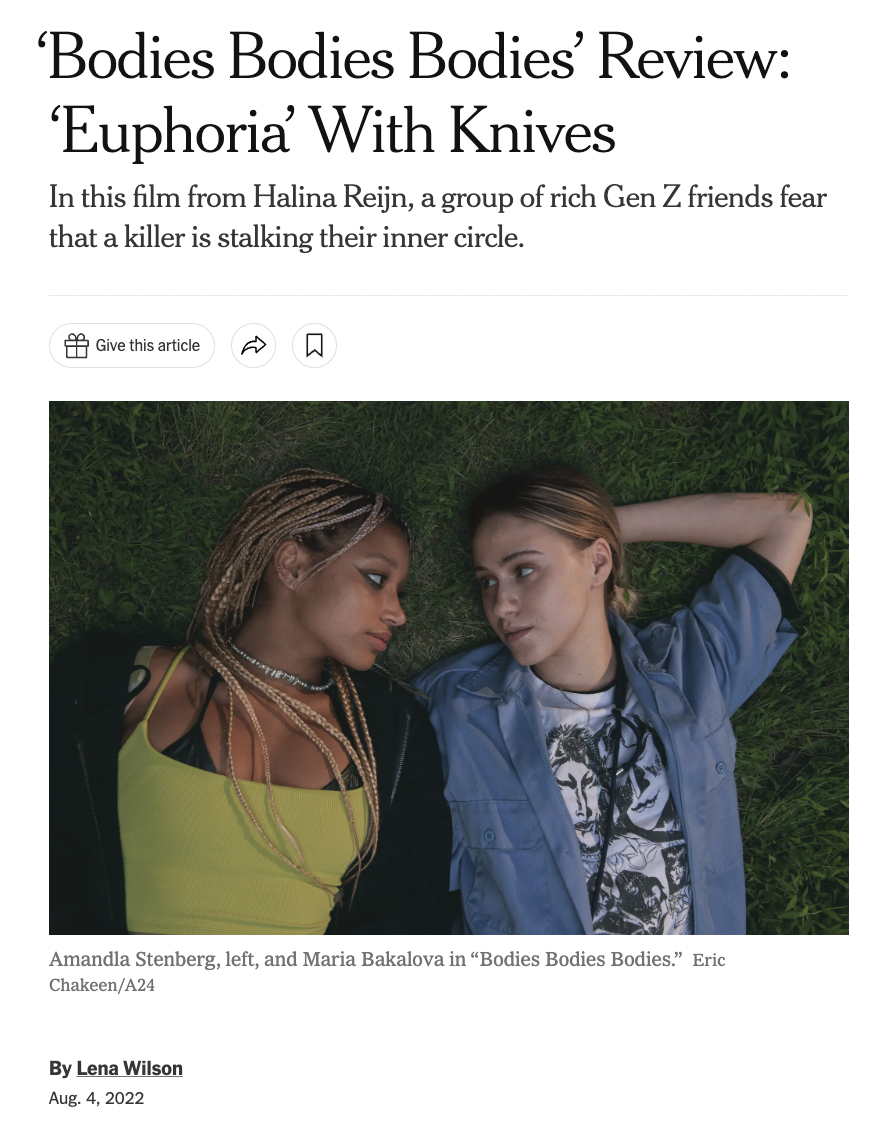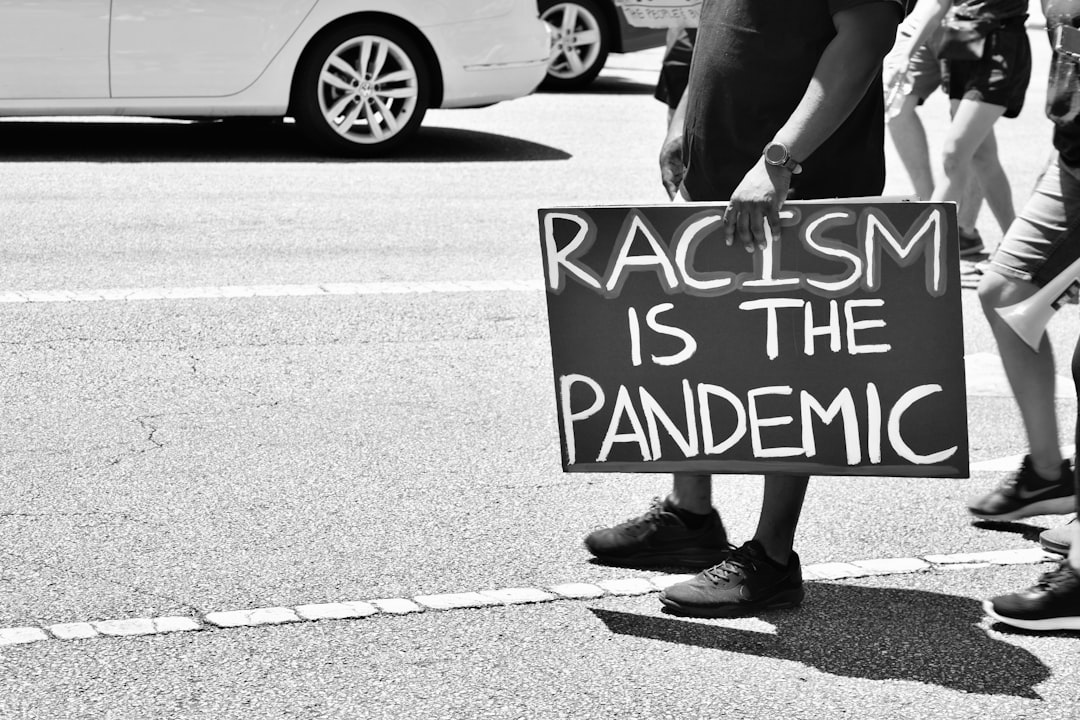On August 18th, 2022 New York Times film critic Lena Wilson posted a now deleted TikTok video which shared a private direct message between her and actress Amandla Stenberg. The message from Stenberg stated, “ur review was great, maybe if you had gotten ur eyes of my tits you could’ve watched the movie!”; to which Wilson responds, “hey, amandla! generally a big fan of your work, but this sure is something. really wishing you well in your career and life. have a nice night.”

Wilson goes on to provide minimal context behind the reasoning for Stenberg’s message, stating, “For context, I reviewed ‘Bodies, Bodies, Bodies’ for the New York Times and didn’t like it. Ironically, I praised the acting though.” The critic continued and writes, “I am devastated to have received this message in the first place. I was genuinely a huge fan of hers, but I’m posting it because I don’t want this person who has more social power than me to think that it’s f*cking okay to do something like this.” Her caption on the TikTok video was, “Unfathomably weird to get ‘I don’t want you in the locker room while I’m changing’ bullying from a whole other lesbian.”
While initially, many comments supported Wilson, it was not long until public opinion shifted around her handling of the situation. Many commenters pointed out that Wilson left out a seemingly vital piece of context that explains Stenberg’s messages, specifically the line in her review stating, “The only thing that really sets “Bodies Bodies Bodies” apart is its place in the A24 hype machine, where it doubles as a 95-minute advertisement for cleavage and Charli XCX’s latest single.” Most notably, many people took issue with Wilson’s statement that Stenberg -a Black, non-binary lesbian - has more social power than herself- a white, lesbian woman who writes for the New York Times.
Stenberg defended themself by remarking that the message was meant to be taken as a joking jab, saying “I thought because Lena is gay — I am also gay — I thought that as gay people we would both find this comment funny”, while also defending their character’s outfit choice: “I can tell you that I wore this tank top in this movie because me and the costume designer thought that it fit the character well." Stenberg ended by saying “Lena, I thought your review was hilarious. I thought my DM was funny. I did not mean to harass you. I do not wish you any harm. You're allowed to have your criticisms on my work and I’m allowed to have criticisms of your work."
Arguably, this piece of internet “drama” has run its course in relevancy. However, there is still a larger issue worth discussing. What many have observed from Wilson’s behavior was a desire to paint Stenberg as the attacker and herself as the victim, despite the Stenberg’s messages being joking in nature and to defend themself. This interaction is a perfect example of the phenomenon of assuming “white innocence”. By automatically victimizing white people and thus assuming “white innocence”, people of color are in turn labeled as the aggressor in the situation.
White Innocence
“White innocence” was first termed by Dutch author Gloria Wekker in her book White Innocence: Paradoxes of Colonialism and Race. While the book focuses specifically on racism in the Netherlands, Wekker delves into the history of colonization and problematic denials of race-based violence that perpetuated a narrative of a “gentle” and “ethical” Dutch ruling. When examining this phenomenon, it becomes clear that colonialism set a precedent for innocence, or lack of fault, becoming synonymous with the white individual.
The “Angry Black Woman” Stereotype
2021 was the first year two Black women CEOs made the Fortune 500 ranking of America’s largest companies. While Black women make up seven percent of the United States workforce, they are highly underrepresented in leadership positions. Studies have shown that the ways in which Black women are treated or perceived in the work place stem from deep rooted stereotypes that cast them as aggressive and overbearing.
@tanita.dee The Angry Black Woman Stereotype #history #blackwomen #storytime ♬ original sound - Tanaïssa
The University of British Columbia conducted a study in which they recorded videos of actors playing employees who received negative feedback from their employer. Their first set of videos displayed actors gently disagreeing with their negative feedback. The second set taped the actors displaying their anger, particularly through raised voices. Among the 300 participants, all of the actors followed the same given script; the only difference was their gender and race.
The employer was asked three questions: “Was the response the result of internal or external factors (i.e., was it the person or the situation that triggered the behavior?)”, “Is the employee a high performer?”, and “Does the employee have potential to be a great leader?” The results of the experiment aligned with the stereotype: Black women were viewed as more likely to attribute their anger to internal factors rather than external factors and receive low performance and leadership evaluations. This affected other groups in the experiment significantly less.
In comparison to white counterparts, as well as Black men, Black women are continually seen as the “attacker” in situations when they express frustration or anger, or even do not. Again, this phenomenon of white innocence takes place, in which groups that more closely align with white men are viewed more mildly for the same action as those not closely aligned with the group. Undermining Black women as potential leaders in professional settings due to these stereotypes can have detrimental effects on upward mobility of Black women in the workplace.
Who is seen as more threatening?
Black men are also stereotyped as threatening, as demonstrated in a study done by the American Psychological Association. The study conducted several tests that asked participants to link different racial backgrounds to different body sizes. The participants matched a man’s face to his body size, answered the amount of physical harm the man could inflict, and provided how justifiable it would be to use violence against the man in the situation of an altercation. An additional study used color-inverted images to remove racial identifiers and asked participants to guess the individual's body size- however, the conductor used stereotypical white/Black names to see how that impacted participants' answers. In reality, all of the pictures used in the study came from a group of individuals with similar body proportions.
The results demonstrated that when participants made the assumption that the man in the image was Black, they imagined the man as larger, more threatening, and having more potential to cause harm in an altercation than if they believed the man in the image to be white.
These stereotypes suggest that Black men take up more physical and threatening space than white men, regardless of their actual size. This similar relationship between race and innocence reveals itself again, with Black men being more likely to be perceived as the attacker or aggressor. These assumptions become more than just a social phenomenon when they bleed into powerful political structures like the justice system.
White innocence in the justice system
When stereotypes are not confronted and unlearned, history repeats itself.
Last month marked the 67th anniversary of the death of Emmett Till, a 14 year old Black boy who was brutally murdered for allegedly whistling at a white woman named Carolyn Bryant. The murderers were the woman’s husband and his brother. Till’s killers were given the verdict of “not guilty” by an all-white jury that deliberated for less than an hour. Bryant later recanted her testimony, stating Till had never touched, threatened, or harassed her. She, however, has never been indicted of a crime.
In 2014, 12 year old Tamir Rice was shot and killed by a white police officer for having a toy gun- the officers involved later reported that they thought Rice was 20 years old.
Both of these tragedies were rooted in racial biases that perpetuated systemic violence. Till, a young Black boy, was perceived as less innocent than a fully-grown white woman merely because of his race. Rice was aged by nearly a decade for this same reason, as Black children have continually been held to an older standard to uphold and protect the concept of “white innocence."

